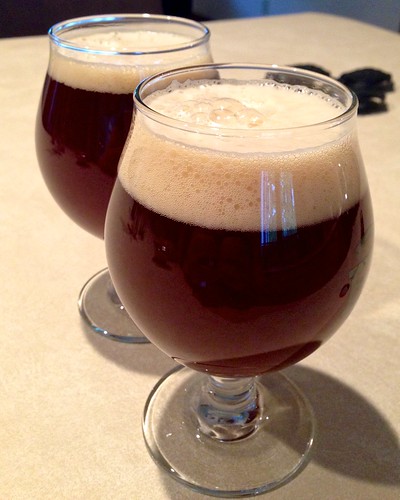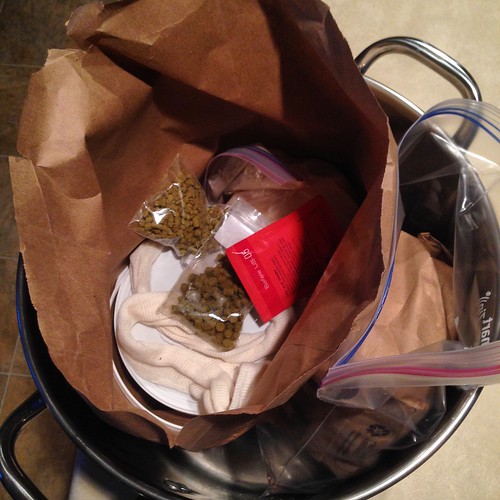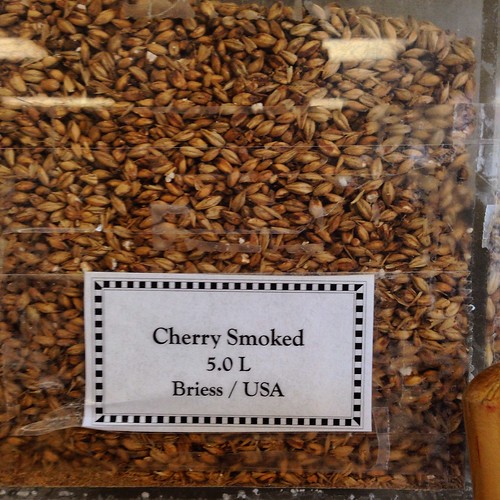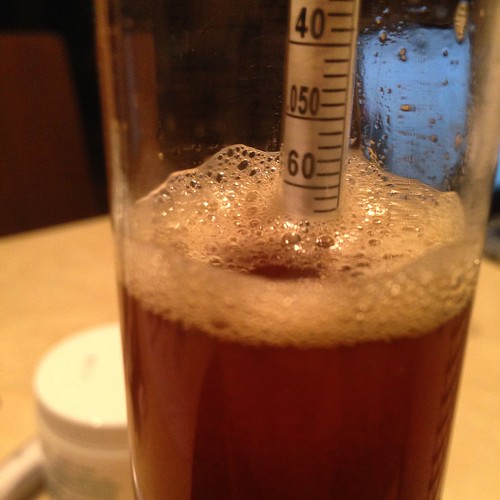Homebrew #9: Honestatis
¶ by Rob FrieselHomebrew #9 was the second Tilde Gravitywerks original: an “accidentally extra” American amber ale that we call Honestatis:
The name translates to honesty from the Latin into English. I chose this name in part as an homage to Felicitas, my first beer. Though I hold no shame over it being an extract (nor a kit), I felt like this was perhaps closer in spirit to the amber ale I was going for all along.
I love a good American amber ale (“red ales”) and for some reason, they seem difficult to come by. I have many fond memories of Casco Bay Brewing Co.’s Rip Tide Red Ale, and though I didn’t want to go exactly for that, it did provide a frame of reference. What I wanted was something dark in the glass, though more red than brown, and with a flavor that hinted at smoke and spicy rye, with something earthy as its base.
Over a couple weeks, I worked out a recipe that was sounding good. The steeping grains were all about flavor: rye and smoked malt and flaked barley. Amber DME and Munich LME would provide the color and the lion’s share of the fermentables. The hopping strategy called on Galena for bittering and Columbia for aroma. Target original gravity was 1.054 which was nice comfortable place to start with ye olde trusty US-05.
However, reality’s circumstances had other ideas for this brew…
Our local HBS didn’t have Munich LME, but amber was a just-fine substitute. A little miscommunication found Columbus rather than Columbia hops in the bag. “But that’s OK,” I told myself, “we can make this work.” Especially since I was getting pretty damned excited about the specific smoked malt choice:
And through a little creative juggling of some of the ingredients (e.g., the hopping schedule), I still felt confident that this was going to work. What I hadn’t accounted for was just how much the additional fermentables were going to raise the original gravity. I knew I had a little extra of both the DME and LME, but well… Whereas I expected to start at 1.054, I found myself hovering around 1.067. 1
I had some concerns that this would be trouble for the “normal size” pitch of US-05. And while I wouldn’t say that these concerns were unfounded, the yeast managed to do a serviceable job and get things down to finishing gravity of 1.015. So… not the target finishing gravity of 1.010, but still acceptable given the calculated 7.14% ABV. 2
After a fermentation completed, and a couple weeks of carboy conditioning, I packaged 19 × 22 oz., plus 8 × 12 oz. bottles. 3
Despite all those missteps and circumstances, I’m very happy with the results. The color is just about exactly what I was going for — a deep, dark ruby red that’s a little bit cloudy (but it’s dark enough that it doesn’t matter too much). The aroma has some earthy/spicy qualities with just a hint of smoke. 4 The flavor has a good balance between the malts and hops, leaning more malty to start (again with that spicy touch of rye) but finishing with an assertive bitterness. (I’m wondering how that would be different if I’d managed to get the Columbia hops, but of well. Next time?) Mouthfeel is full and chewy. Overall? Very happy with how this pours and drinks.
Recipe
The extract recipe for Honestatis is as follows (with originals struck out and actuals highlighted as such).
Steeping Grains
- ½ lb. flaked barley
- 1⅛ lb. Crystal Rye
- ⅜ lb. Cherry-Smoked Malt
Fermentables
2½3 lb. amber DME4 lb. Munich4 ½ lb. amber LME
Hop Schedule
- 1 oz. Galena (60 min.)
- 1 oz.
ColumbiaColumbus (flame-out)
Yeast
- Fermentis Safale US-05
Brew Day
- Collect 3 gal. water and heat to 170°F.
- Steep the steeping grains for 170°F for 30 min.
- Bring to a boil and add fermentables and Galena hops.
- Boil for 60 minutes.
- Add Columbus hops at flame-out.
- Cool to 100°F as rapidly as possible and top off the fermenter to reach 5 gal.
- Aerate wort and pitch Safale US-05 yeast when the temperature is in the right range.
Beyond Brew Day
- After fermentation completes, rack to a carboy.
- Allow beer to condition for approx. 2 weeks.
- Corn sugar to carbonate on bottling day.
- Allow for about 2 weeks to carbonate.
- Enjoy.
Details
Honestatis, an original American amber ale by Tilde Gravitywerks
| Original Gravity | 1.067 (16%Br) |
| Final Gravity | 1.015 (8.1%Br) |
| ABV | 7.14% |
| Attenuation | 79.1% |
| IBU | |
| SRM | |
| Links | Untappd Flickr |
- As a sidebar to the discussion about the starting gravity: I had a very interesting conversation with one of the proprietors of our local HBS about what I planned vs. where I finished. Given all of the above, she concluded that (1) the “left-over” LME and DME that I used account for most of the “extra” gravity, but that (2) I probably also extracted more sugars from the steeping grains than I’d otherwise planned. At first she thought I was just taking bad readings, but after walking through my process (i.e., calibrating the refractometer, cross-validating it with a hydrometer reading, controlling for temperature, etc.), she felt pretty confident that her explanation held up. And/but/so: then we had a fun little tangent about the “Imperial” vs. “double” qualifiers, and what other words could be used there. (We both liked “extra”.)[↩]
- I think I could have gotten it down a few more points. If I’d pitched a double dose of US-05, or if I’d used a starter, maybe? Either way, it’s certainly a good place to end up. Filed under: Good Problems to Have.[↩]
- Six of those 12 oz. bottles were set aside for aging.[↩]
- I’d originally planned to use more of the smoked malt but a friend talked me down. “That’s a strong ingredient,” he said. “You’ll regret it if you overload. You can always use more next time.” And I probably will.[↩]
About Rob Friesel
Software engineer by day. Science fiction writer by night. Weekend homebrewer, beer educator at Black Flannel, and Certified Cicerone. Author of The PhantomJS Cookbook and a short story in Please Do Not Remove. View all posts by Rob Friesel →7 Responses to Homebrew #9: Honestatis
Pingback: Homebrew #81: Half Dark | found drama





Leave a Reply